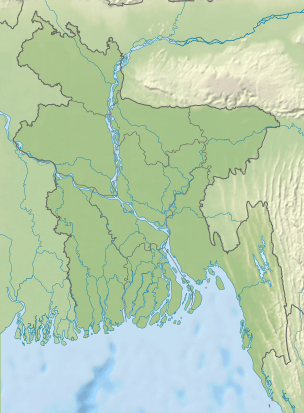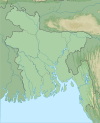Himchari National Park
Himchari National Park (Bengali: হিমছড়ি জাতীয় উদ্যান) is a major national park and nature reserve in Bangladesh. The park is located at Ramu and Cox's Bazar Sadar Upazila, Cox's Bazar District, in the southeast region of the country. It is located mainly on the hills and is adjoining to Bay of Bengal to the west. Himchari National Park covers approximately 1,729 ha (17.29 km2) of mixed evergreen forests Biome. It was declared a protected area in 1980.[1]
| Himchari National Park | |
|---|---|
IUCN category IV (habitat/species management area) | |
 Himchari National Park Location in Bangladesh | |
| Location | Cox's Bazar District, Cox's Bazar Division, Bangladesh |
| Nearest city | Cox's Bazar |
| Coordinates | 21°21′17.4″N 92°02′50.0″E |
| Area | 1729.00 hectares |
| Established | 15-2-1980 |
Location
It is located 13 km East of Cox's Bazar town. The overall appearance of the forest is various patches of dense forest and grass lands. The climate is generally humid and warm. The park has tropical monsoons from June to September every year. The soil is loamy, clay and sandy loam at various places.
Administration
The entire forest area is managed and is under the jurisdiction of Cox’s Bazar South Forest Division. There are four forest beats in the parks namely Kolatoli, Chainda, Jhilongja and Link Road.The place is visited mostly for the famous broken hills and Row of christmas trees.[2]
Biodiversity
Flora
The general walk in the forest is not easy due to hilly terrain and dense vegetation. About 117 tree species belonging to 37 families have been recorded. Some near-endangered plant species recorded are Elaeis guineensis, Garcinia lanceifolia, Elaeocarpus tectorius, Elaeocarpus floribundus, Suregada multiflora, Lithocarpus elegans var. elegans and Acronychia pedunculata.
Fauna
The fauna consists mainly of Ridley sea turtle, 286 bird species[3] and 26 mammal species. The barn swallow and Asian palm swift are common birds in the national park. Mammals include Hoolock gibbon, leopard cat, fishing cat, tiger, sloth bear, Asian elephant,[4] wild boar, Rhesus macaque and mongoose.
Human Settlement
There are 4000 people living inside the National park area. They are mostly migrants and are involved in fishing and cultivation for their livelihood.
Threats
The loss of tree diversity and population is due to encrochments for cultivation, invasion of weed species, grazing of cattles, collection of minor forest produces and fuel wood, fire hazard, expansion of network of roads and other infrastructure projects.
References
- Hossen, S; Hossain, Mk (2018-12-17). "Conservation status of tree species in Himchari National Park of Cox's Bazar, Bangladesh". Journal of Biodiversity Conservation and Bioresource Management. 4 (2): 1–10. doi:10.3329/jbcbm.v4i2.39842. ISSN 2412-2416.
- http://en.banglapedia.org/index.php?title=Cox%27s_Bazar
- "Discover and Expore Bangladesh | By Bangladesh.com | Himchari National Park, Cox's Bazaar". bangladesh.com. Retrieved 2019-11-22.
- "nishorgo.org/project/himchari-national-park/". nishorgo.org. Retrieved 2019-11-22.
